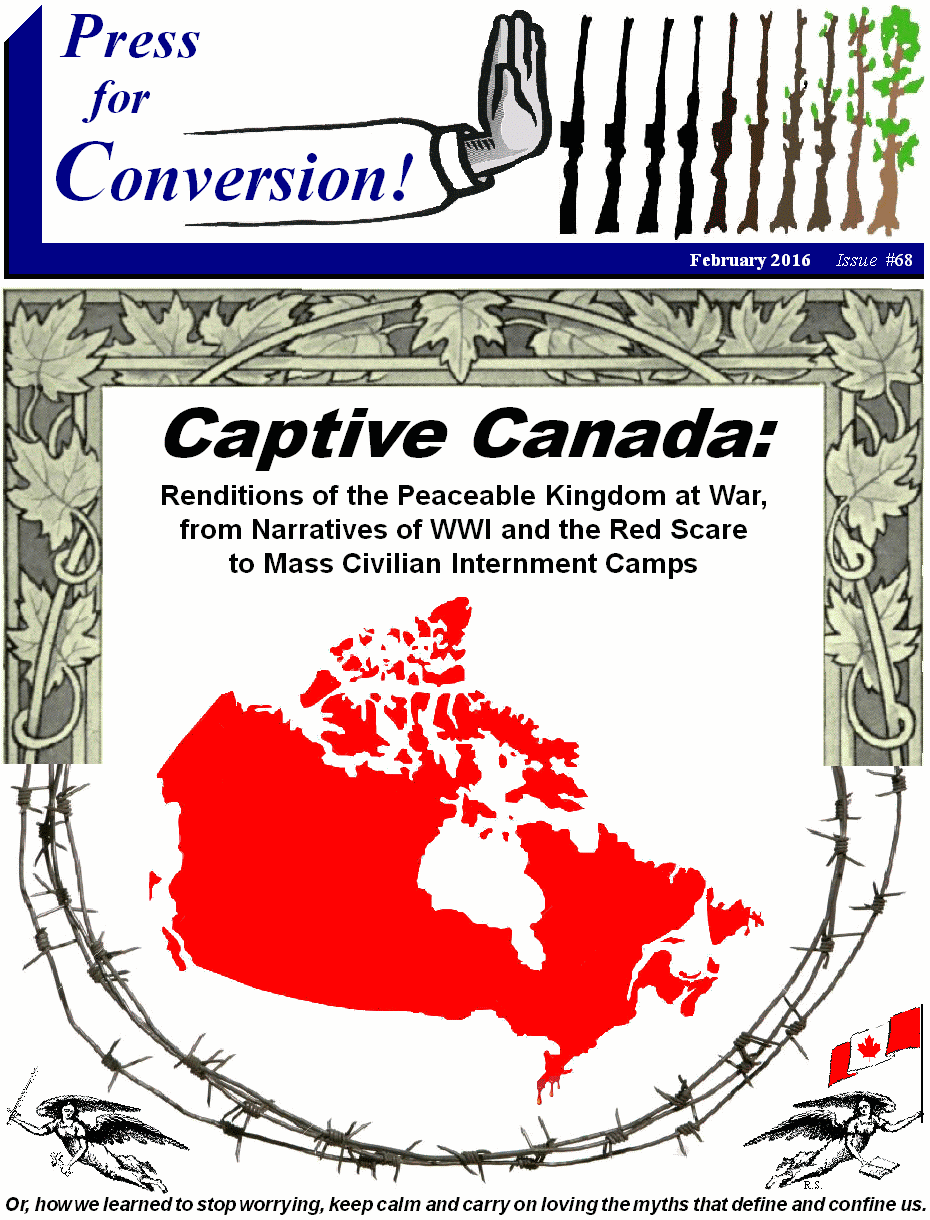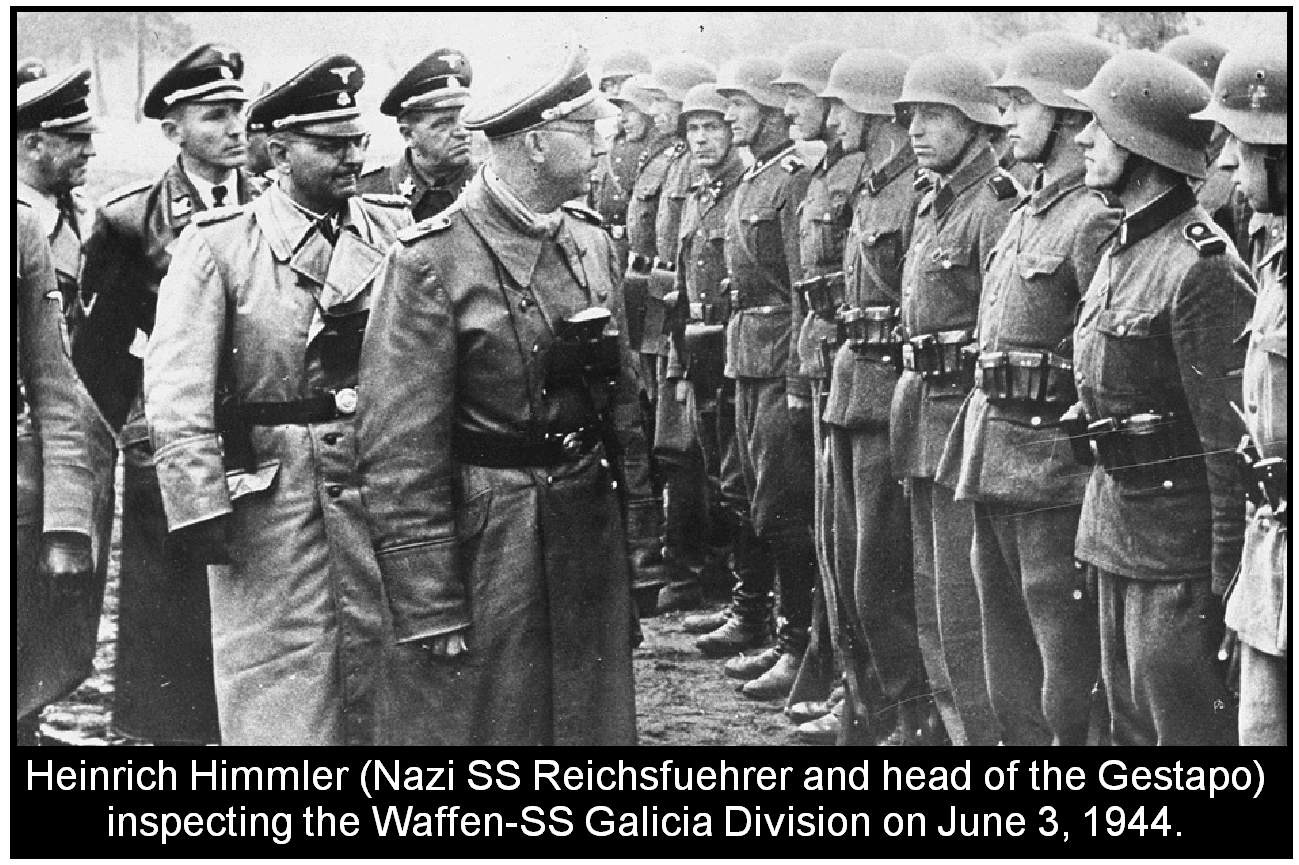
This
article was written for and first published in
Captive Canada:
Renditions of the Peaceable Kingdom at War,
from Narratives of WWI and the Red Scare to the Mass Internment of Civilians
Issue #68 of
Press for Conversion (Spring 2016),
pp.48-49.
Press for Conversion! is the magazine of the
Coalition to Oppose the Arms Trade
(COAT).
Please subscribe, order a copy &/or donate with this
coupon,
or use the paypal link on our webpage.
If you quote this article, please cite the source above.
And, please consider subscribing, ordering a copy &/or donating. Thanks!
Here is the pdf version of this
article as it appears in Press for Conversion!

Waffen-SS Galician Division still Revered by Canada’s Ukrainian Right
By Richard Sanders, Coordinator,
Coalition to
Oppose the Arms Trade (COAT)
After its creation by Reichsführer Heinrich Himmler, recruitment for the
Galician SS began in May 1943. While over 70,000 Ukrainians volunteered, but
only 13,000 made the cut.
Ukrainian Catholic and Orthodox churches helped rally
this SS Division and then supplied it with military chaplains. Religious,
ethnic and political symbols were congealed to inspire hatred of Jews and
Communists. For example, a 1944 Easter greeting from the Galician SS—depicting
a smiling couple in traditional dress—said: “Christ has arisen! Only with the
faithful brotherhood of the Waffen-SS can we save Ukraine from judeocommunist
dominance!”1 And, as Volodymyr Kubijovy, the Ukrainian-Polish politician who
helped create the Galician SS, proclaimed in 1943:
“The Fuehrer of the Great German Reich has agreed to the formation of a
separate Ukrainian volunteer military unit under the name SS Riflemen’s
Division ‘Halychyna’ [Galician].... You must stand shoulder to shoulder with
the unbeatable German army and destroy, once and for all, the
Jewish-Bolshevist monster.”2
Not only did it join the Nazi war against the Soviet
Army, the Galician SS also murdered Jews, Communist partisans and villagers
trying to protect them. Created, financed, trained and armed by the Nazis, the
Galician SS was integral to the German military. Commanded by fanatical
Brigadeführer Fritz Freitag, all Galician SS troops took this vow to Hitler:
“I swear before God this holy oath, that in the battle against Bolshevism,
I will give absolute obedience to the commander in chief of the German Armed
Forces Adolf Hitler, and as a brave soldier, I will always be prepared to lay
down my life.”3
Recruits swore this “holy oath” after a religious service led by military
chaplain Vasyl’ Laba. After coming to Canada, Laba was the Ukrainian Catholic
“vicar at the Edmonton eparchy from 1950 and became honorary member of the
Ukrainian War Veterans Association in Edmonton.”4
In Murderous Elite, on Waffen-SS history, James Pontolillo details a litany of “extermination operations” in which Galician SS units “murdered thousands of innocent civilians.” For example, in the summer of 1943, Division members joined “anti-partisan operations in Poland which resulted in the wholesale murder of innocent civilians.” Later that year, “divisional elements assisted in the deportation of Polish Jews to KL [concentration camp] Auschwitz for extermination.”5
While fighting in German-occupied Poland in January 1944, the Galician-SS engaged “in mass executions of Ukrainians, Jews, and Poles...under a pretext of anti-partisan actions,”6 says University of Ottawa political scientist Ivan Katchanovski. In February 1944, the Galician Division’s 4th SS police regiment helped kill 500 to 1,500 civilians in Huta Pieniacka, Poland, where 120 houses were incinerated. While children were killed in front of their parents, hundreds were herded into barns and burned alive. In March, this same regiment helped kill hundreds of villagers hiding in a monastery in Podkamien, Poland. These crimes were part of the “pacification” of eastern Galicia. Poles were targeted for hiding Jews or for aiding the local communists who were fighting the Nazis.7 These SS operations “destroyed 20 villages,” killed more than “5,000 innocent people, and shipped... 20,000 civilians off to Germany as slave laborers.”8
After being largely routed by the Soviets in July 1944, the Galician SS was replenished and redeployed to Slovakia. There it joined other SS units in suppressing the Slovak National Uprising which was fighting the Nazi’s clerico-fascist puppet regime. The Galician SS helped kill Slovak civilians, and burned villages that were helping partisans and hiding Jews.9
Although the Galician SS was declared a criminal organisation at the Nuremberg war crime trials, Canada’s Ukrainian Right has always memorialised these WWII vets as anticommunist heroes. They have done this in a myriad of ways from speeches, media releases and ceremonies to public monuments and academic endowments. For example, the University of Alberta’s Canadian Institute of Ukrainian Studies (CIUS), administers four endowments to honour leading Waffen-SS veterans who came to Canada.10 The CIUS also publishs the Encyclopedia of Ukraine, which claims “there has never...been a Ukrainian anti-Semitic organization or political party.”11
Historian Per Rudling says the Waffen SS Galicia “has
been the object of intense myth making” and is “glorified” by Canada’s
Ukrainian Right. “A sanitized, ideological narrative of the unit’s history has
become an integral part of the Ukrainian diaspora’s culture of memory,” says
Rudling, and “ritualized veneration of the unit became part of the ideological
training of many diaspora youth organizations.”12 Their rendition of history
relies on a “self-serving historical mythology”:
“Even the Ukrainian Waffen-SS veterans’ investment in a fascist Europe was
denied, and they remain respected and venerated as heroes and pillars of the
community.”
Canadian governments, says Rudling, have
“helped...develop and retain their myths, facilitated their history writing,
[and] funded their activities down to the construction of nationalist
monuments.”13
References
1. Per Anders Rudling, “‘The Honor They So Clearly Deserve’: Legitimizing
the Waffen-SS Galizien,” The Journal of Slavic Military Studies 26:1, 2013.
http://www.academia.edu/2763263
2. “WJC urges Ukrainian Orthodox Church leader to act
against glorification of Nazi soldiers,” August 22, 2013.
http://risu.org.ua
3. Per Anders Rudling, “‘They Defended Ukraine’: The
14. Waffen-Grenadier-Division derSS (Galizische Nr. 1) Revisited,” Journal of
Slavic Military Studies, Sept. 2012, p.343.
http://www.academia.edu/1908894/_They_Defended_Ukraine_The_14._Waffen-Grenadier-Division_der_SS_Galizische_Nr._1_Revisited_The_Journal_of_Slavic_Military_Studies_25_3_2012_329-368
4. Ibid.
5. James Pontolillo, Murderous Elite: Waffen
SS and its Record of Atrocities, 2009.
http://forum.axishistory.com/viewtopic.php?f=6&t=163468
6. Ivan Katchanovski, “The OUN, the UPA, and the Nazi-led Genocide in Ukraine,” 2010, pp.27-28, cited by Rudling 2012, Op.cit., pp.358-359.
7. Ibid., pp.346-356.
8. Pontolillo, Op. cit., pp.51-54.
9. Michal Šmigel and Aleksandr Cherkasov, “The 14th
Waffen-Grenadier-Division of the SS ‘Galizien No.1’ in Slovakia (1944-1945):
Battles and Repressions,” Bylye Gody, 2013, No. 28(2), p.66.
http://bg.sutr.ru/journals_n/1374766084.pdf
10. Rudling 2012, Op. cit., p.331
11. Per Anders Rudling, “The OUN, the UPA and the
Holocaust: A Study in the Manufacturing of Historical Myths,” The Carl Beck
Papers, November 2011, pp.21,58.
https://carlbeckpapers.pitt.edu/ojs/index.php/cbp/article/view/164/160
12. Rudling 2013, Op. cit., pp.115, 135
13. Per Anders Rudling, “Multiculturalism, Memory, and
Ritualization: Ukrainian Nationalist Monuments in Edmonton, Alberta,”
Nationalities Papers, September 2011, pp.737, 756.
http://www.academia.edu/938636/_Multiculturalism_Memory_and_Ritualization_Ukrainian_Nationalist_Monuments_in_Edmonton_Alberta_Nationalities_Papers_Vol._39_no._5_September_2011_733-768